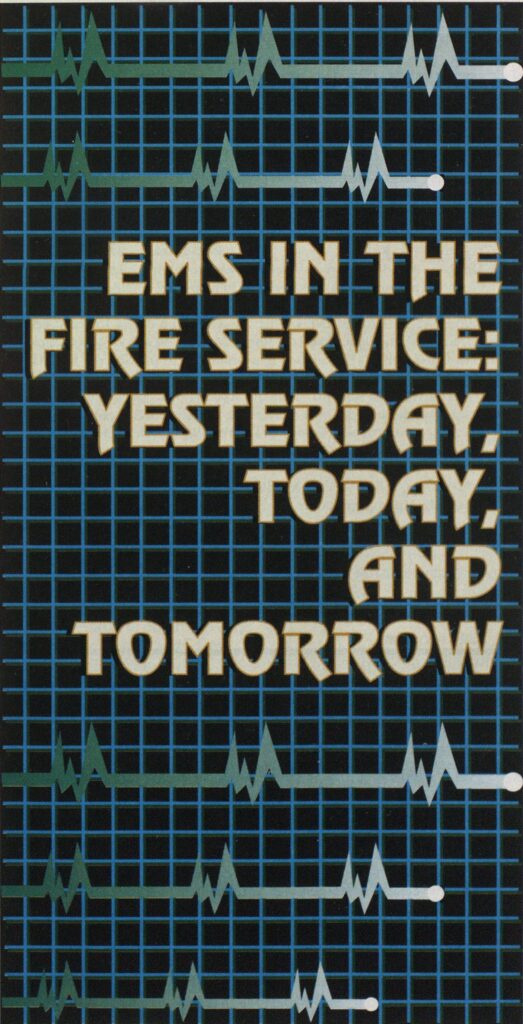
EMS IN THE FIRE SERVICE: YESTERDAY, TODAY, AND TOMORROW
D. H. HIETT, JR.

The fire service has been actively involved in emergency medical services for hundreds of years. The annals of England’s Knights of St. John, for instance, provide us with a clear image of early “firefighters” rescuing and providing medical assistance to soldiers and civilians involved in warfare whose weaponry included the use of fire. This group of knights, with life safety as its primary goal, has endured through time; we know it now as the St. John’s Ambulance Service.
The fire service has come a long way since the days of knights in shining armor: horse-drawn rescue vans and ambulances; extrication devices such as the Detroit door opener, the crow bar, and the pinch bar; the Pulman motor resuscitator; and other devices that we now look upon as crude. Hut all along, our medical intervention activities have been apparent. l ire service personnel are credited with inventing and first using many devices to expedite and enhance patient care. Fire departments were among the first organizations to administer oxygen outside the hospital environment; equip vehicles with stretchers, bandages, and splints; and implement hydraulic extrication equipment as part of standard operating procedures.
Today’s fire service continues to stand as the primary prehospital care provider and continues to expand and seek ways to improve that care. All members are involved in HMS—care begins when you pull a victim out of the fire environment. Our services range from the first responder (ambulance, rescue, engine, and truck companies) to the transportation provider (ambulance and sometimes engine companies) and include basic life support with airway management, bleeding control, and circulation assistance; automatic defibrillation for cardiac arrest; advanced life support and stabilization in the field; and control of the hospital closure in a specific jurisdiction with respect to crowding and overloading of emergency departments Many departments are involved in the National Disaster Medical System, disaster medical assistance teams, and urban search and rescue teams —all key components of the I MS system. Many departments have developed management systems, dispatch and communications systems, and quality assurance programs to support EMS operations in their jurisdiction.
Fire departments are looking to tomorrow to analyze how they might provide more cost-effective medical services in many areas —from haz-nvat response to confined space rescue to high-rise fire and rescue operations. W e re hiring and/or training emergency medical technicians to complement our firefighting forces. We’re looking toward equipment specifications that tie fire service rigs to emergency rooms on wheels and toward enlightened applications for dual-service vehicles.
As firefighting in the next century becomes oriented more toward specialized services, the fire service must keep in step with the times and strengthen the bond between fire and EMS We must solicit citizens’ support and educate them in EMS life safety; market the considerable advantages ot the fire/EMS union to those who demand that we “justify our existence”; and. above all, strive to provide the most effective and comprehensive community protection possible Whatever happens between receipt of alarm and hospital arrival is in the fire service’s hands *
THE INTERNATIONAL ASSOCIATION OF FIRE CHIEFS and THE INTERNATIONAL ASSOCIATION OF FIRE FIGHTERS JOINT RESOLUTION on EMERGENCY MEDICAL SERVICES
WHEREAS, Pre-hospital emergency medical care is a major service provided by America’s fire service; and
WHEREAS, As first responders to most emergency situations, it is imperative that the fire service continue to provide pre-hospital medical care; and
WHEREAS, The fire service has been hampered by a lack of public recognition and support for its vital role in providing emergency medical care;
THEREFORE BE IT RESOLVED, That the leadership of the International Association of Fire Fighters and the International Association of Fire Chiefs agrees that America’s fire service must continue to provide pre-hospital emergency medical care; and
BE IT FURTHER RESOLVED, That the International Association of Fire Fighters and the International Association of Fire Chiefs urge all elected officials, professional associations and health care providers to recognize and support the provision of emergency medical care by the fire service.
Adopted by
Chief W.D. Hilton, President
International Association
of Fire Chiefs
Alfred K. Whitehead, President
International Association
of Fire Fighters
January 9, 1991
Washington, DC
Mission Statement USFA Emergency Medical Services Program
Fhe nation’s fire service is recognized as first responders to medical and other emergencies. The vast majority of fire departments in this country provide some level of emergency medical service, and the majority of the emergency activity within these departments is medical-related. Thus, a critical part of fire service management is the management of pre-hospital emergency medical services.
The mission of the United States Fire Administration (USFA) is, in part, to increase the efficiency and effectiveness of fire service management across the country. The purpose of the Emergency Medical Services Program of the USFA is to address a major component of this issue —the management of emergency medical services. USFA will conduct research, produce publications, disseminate information, and cooperate with other agencies and organizations in an ongoing effort to increase the efficiency and effectiveness of die management of pre-hospital emergency medical services.

